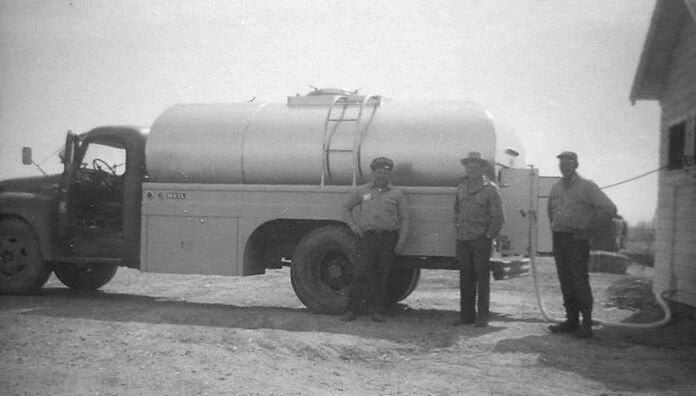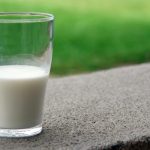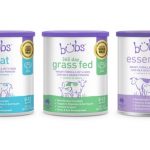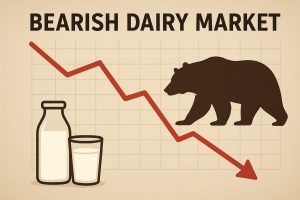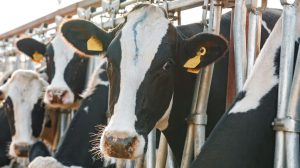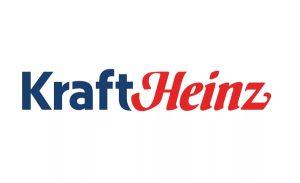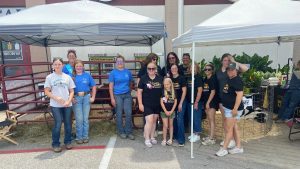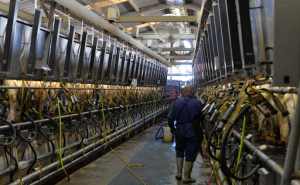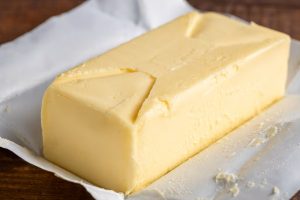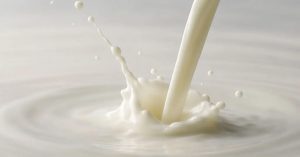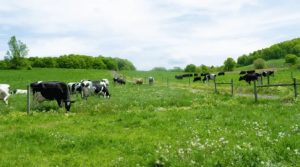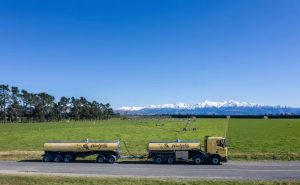
The look of Fremont County agriculture has changed dramatically since territorial days. The vast expanse of sagebrush that was the Wind River Valley before 1906 largely remains, but pockets of irrigated land have made the desert bloom wherever ditches, canals, and dams have been able to divert water from the Wind River.
Beginning in the 1870s, sheep dominated the county with an estimated 1.5 million head spread from Nowood Canyon above Lost Cabin to the base of the Wind River Reservation in the west and all along the Sweetwater River between Split Rock and South Pass City.

When irrigation arrived with the Central Wyoming Irrigation Company and later the reclamation project centered around Pavillion, the landscape began to change.
Every pioneer arrived with a milk cow. They could be from any of a dozen or more breeds. Jersey, Guernsey, Ayrshire, Brown Swiss, Holstein, and Milking Shorthorn were the dominant breeds, but there were many others.
By the 1920s, dairy farms began to pop up across the Wind River Country, with Jersey, Holstein, and Brown Swiss dairy herds. There were a few Ayrshire cows on individual farms, but no records of established dairy herds can be found.
By the 1940s, with the increased demand for milk brought on by World War II, dairies began to proliferate.

The peak for dairy farms in Fremont County was in the 1950s. An estimated 65 dairies operated across the county. By 1970, about 50 were in operation. Today, none remain.
A few “Artisan Dairies” still operate with a handful of cows, or a few dozen goats, but commercial dairies no longer exist.

The George Dairy Farm in Powell is the state’s largest, with a milking herd of 500 cows. Other smaller dairies operated near Afton in the Star Valley, but the heyday of milk production, with much of it centered in Fremont, Goshen, and Big Horn counties, passed before the turn of the millennium.
A hotbed of dairy farming was along present-day Gabes Road between US Highway 26 and Missouri Valley Road. In the 1960s through the early 70s, Richard Stearns and his aunt Pauline Stearns operated dairies of around 100 to 120 milking cows established by Art and Ted Stearns, along with a much smaller dairy operated by Roy Walker on land rented from Rex Peters. The Brubaker and Stowe Dairies were larger operations, with Bob and Joanne Jeffries and Nils and Karen Gabrielson milking substantial herds as well.

Missouri Valley, Hidden Valley, Lyons Valley, Hudson, Arapahoe, and the area north of Lander towards Ft. Washakie all had dairy farms dotting the landscape.

Milking cows requires processing, and none of these dairies produced homogenized milk, or made butter. That was another lost component of a once vibrant milk-based economy.
The Morning Star Dairy in Riverton owned by Leroy Peck family and the Riverton Creamery owned by Jigs Woodward family were the destinations of raw milk, hauled in spotless, stainless-steel tanks on double-axle trucks. Morning Star was adjacent to the Peck, Mund and Sackman dairy farms that supplied all the milk they needed in the early years. In 1965, Morning Star was sold and became Cream of Weber.

In the early history of Fremont County, Shoshoni, Lander, Hudson, and Dubois all had creameries. The Basketeria in Pavillion operated a creamery for several years during World War II, but improvements in roads centralized the process to Riverton.

The Mountain Empire Dairy Association (MEDA) sent trucks out to bring in milk from dairies across the county. MEDA was part of a larger, nationwide distribution network of dairy associations stretching from the Great Lakes to California.

A dairy truck is different from a water, or fuel truck. It requires a lot more skill for a driver to operate.
Fuel trucks and water trucks have baffles installed in the tank. These baffles prevent “sloshing” of the liquid contents when a truck turns or makes a sudden stop. Those don’t exist in a dairy truck.
The baffles would harbor bacteria and, on a prolonged run, would begin to agitate the milk, creating thicker whole milk, and on twisting roads, even begin the butter-making process.
Slamming on the brakes with a load of milk, in an unbaffled tank could throw the truck through an intersection and the sloshing of the load sideways could easily roll it on a sharp turn.
The Leonhardt family is indicative of the lives of dairy farmers. Paul, Art, and Emil all operated dairies along Missouri Valley Road.

Paul was a big man, with the largest hands you’d probably ever see on a person outside the NBA. He could hide a can of beer in one hand as easily as the best Las Vegas magician. Which he often did to avoid a lecture from his wife, Pauline.
Paul and Pauline raised five children on their dairy farm, with Pauline working in Riverton as a nurse.
In their final years on the dairy, their daughter Debbie and her husband Tad McMillan moved out to help with the dairy.
From 1984 to 1990, McMillans and Leonhardts kept the dairy going despite a drop in milk prices and a nationwide trend for consolidation in dairy farming. This consolidation eventually shut down the family dairy farm completely, changing the industry to gigantic industrial dairies milking up to 4,000 cows, three times a day.
That wasn’t the operation across Fremont County.

One year, Paul suffered a bone spur in his ankle.
“I’ll get it removed over Christmas break,” Paul thought in an effort to help Tad during his holiday vacation as the Vocational Agriculture teacher at Riverton High School.
Complications set in, followed by an infection.
“I milked two weeks during Christmas break. Then milked another three weeks while lambing 250 ewes and still teaching school,” Tad said. “Deb would set up the barn in the afternoon to milk. We’d start at 3:30 am again to get to school by 7:30.”
It was a very long winter until Paul was literally back on his feet.
Tad had a little background in running a dairy but learned it as a boy on his Grandpa Franklin’s dairy in Powell.
Like most dairy farmers, Paul ran Holstein-Friesen cows. Holsteins are much larger than Guernsey or Jersey cows, and while their butter fat is lower, their milk volume is much greater than the smaller breeds.

“He wanted some red Holsteins, so he got a red Holstein bull,” Tad said. “It was a novelty.”
Red Holsteins, like Red Angus, are identical genetically to traditional Holsteins and Black Angus, they just carry a mutation that changes black to red.
At its largest, the Paul Leonhardt dairy milked 100 cows, twice a day.

When the Morning Star Dairy and the Riverton Creamery were in operation, the milk was delivered directly to Riverton. Riverton’s first creamery opened on December 1, 1922. The A, B, C Creamery took local milk and made butter, buttermilk, ice cream and soft drinks. In their first week of operation, they produced 315 pounds of butter, three years later they averaged 1,700 pounds per week.

Lander had a growing creamery beginning in 1911.
In later years, after the closing of both plants in Riverton, the milk was gathered, then trucked to the Co-Op in Riverton, where it was transferred to tractor-trailer tankers and taken to Afton to be made into cheese.

MEDA picked up milk from dairies every two days on established routes.
Depending on the size of the dairy, their holding tank could vary from 500 to 2500 gallons. As the cows were milked, the milk flowed through a system of stainless-steel lines to the holding tank.

Each load of milk was stringently tested for bacteria and butterfat content. Butterfat paid the bills. The higher the fat content, the more the milk was worth. Value-added dairy products like butter, cheese, sour cream, and cottage cheese required butterfat to create, so the higher the fat, the more the milk was worth.

In a holding tank, the cream naturally rises to the top. Homogenization forces fat molecules to blend into the milk so cream won’t rise since it’s been encapsulated into the milk. That’s not how it works with raw, natural milk.

“We would get in trouble every once in a while. If you didn’t turn the mixer and dipped a gallon of cream off the top,” Tad said. “It affected the butterfat, every load was tested
The MEDA truck picked up milk from three or four dairies at a time. If your milk didn’t pass, you paid the other farmers for their load since the entire tank had to be dumped.

“It never happened to Paul,” Tad said. “You kept that in the back of your mind.”
Cows get sick just like humans. If a cow wasn’t at the top of their game, they still had to be milked. When that happened, the milker flipped a valve, and the milk was dumped rather than pumping it into the main holding tank.
There is an old joke among dairy farmers that you should just add a restaurant or build a motel on the farm since you’re never able to leave. Being tied to a rigorous schedule of milking twice a day, 365 days a year can be taxing. Even with relief from families, friends, or hired helpers, the worry remained with the farmer, and it never left. Most husband and wife operations never took a single holiday, remaining on the farm for years with the only break a trip to town between milkings for parts, groceries, or the occasional doctor or dentist visit.

In between the twice-daily milkings, traditional farm work took place.
Nancy Stearns grew up on the family dairy near Gabes Road and related how her family worked on the farm.
“If I close my eyes and concentrate, I can hear the steady beat of windrower as it clears the field and smell the sweet, fresh-cut alfalfa. I can almost taste the sweet and tender stem of alfalfa plucked from the windrow.
No doubt, you’ve heard the term, “making hay while the sun shines,” but truth be told, farmers and ranchers often work long into the night to put up the hay. Notice the light on the black bar directly above the right-hand tire in the photo above. That is a headlight for cutting alfalfa at night. My brother was often in the field well past dark because he put up hay on two farms that were 10 miles apart. Other farm chores – milking and irrigating – took precedence during daylight hours.” – Nancy Stearns – https://wyomingbreezes.blogspot.com/2013/07/haying-time.html
Cows need feed, so dairy farms raised alfalfa, corn, and oats. They needed grazing areas to stay healthy, and pastures had to be watered.

Grazing dairy cattle is more challenging than beef cows. Nobody cares if an Angus or Hereford snacks on wild onions or another foul weed. If a dairy cow does it, you’ll taste the change in the milk. Keeping dairy pastures weed free was a requirement.
People take produce for granted today, but the job of a farm wife never ended when it came to providing for her family.
Nancy noted the never-ending work her mother did to provide for the family.

“In order to feed the family through the winter, my mother canned a lot in the 50s and 60s. She grew corn, pumpkins, winter and summer squash, beets, carrots, turnips, tomatoes, cucumbers, peas, kohlrabi, green beans, lettuce, radishes, zucchini, and potatoes. Hoes and a hand-powered cultivator were used to keep the weeds under control.
Mom frequently purchased bushel baskets (the real, wooden ones with slat lids) of peaches and pears, which she also canned. The pressurized canner and Mason jars got a good workout every fall. The canned goods, winter squash, potatoes, apples, etc. were stored in an underground root cellar. – Nancy Stearns – https://wyomingbreezes.blogspot.com/2012/10/family-farm.html
Dairy herds must be maintained with a constant rotation of cows. A cow can lactate from six to nine months but must have a calf to produce milk. Cycling production cows and gestating cows require meticulous record keeping.
Only half of the calves are female. Most heifers are rotated back into the herd. A bull is only good for two years to avoid in-line breeding back to its own offspring which can produce genetic defects.

Those bull calves are often sold to traditional cattle ranches where they’re raised and then sold as beef. The largest hamburger breed in America is Holstein. In 2022, there were 9.35 million milk cows in the United States. Every year about five million dairy steers and spayed heifers are slaughtered for beef.
A celebrity panel judged a dozen beef samples in a recent “Beef Cookoff” at the opening of the new equine center at Central Wyoming College. The winner was a New York strip and rib steak from a Holstein in Wisconsin. They make excellent beef when finished properly and are larger than traditional beef breeds.
Dairy cattle are particular animals. In a small family-operated dairy their personalities emerge. They have a standard milking order and if one cow steps in front of another, a fight quickly ensues with the offended cow staunchly defending her place in line as they butt heads and shove each other.

At the Ted Stearns dairy, operated by his son Bob and wife Pauline in the 1970s, they milked about 110 head twice a day. To increase butterfat content, Pauline had 15 Jersey cows mixed with her herd of 85 Holsteins.
The Jersey have substantially higher butterfat in their milk, but a much lower volume since they are much smaller cows. The ratio worked with the Stearns dairy consistently producing high butterfat milk.
“The biggest milking herd we ever had was 122 cows in a string,” Bob said.
The dairy had a 1,250-gallon holding tank.

“Before we started shipping grade A dairy, we took cream into Morning Star,” Bob said. “We cashed it there or gave some to Eldon Jones at the Basketeria in exchange for groceries.”
They closed the dairy in 1978 and it sat idle for a few years. A family named Hanson moved in and milked another couple of years before the dairy farm closed for good.
On the other end of the production cycle was the morning milkman making his rounds delivering locally processed milk, buttermilk, and locally made butter.

A Morning Star truck in the pre-dawn hours was a common site in Riverton. A small, insulated metal box sat on the front step. Inside were clean, empty milk bottles and an order for the next delivery. The milkman took the empty bottles, dropped in fresh, new bottles of milk, along with cheese, butter, or other dairy products, took the new order, wrote it down in his delivery book, and moved to the next house, all before anyone at the home was awake.
Those days are gone. Milk is delivered several days a week to supermarkets, with the only local supply from artisan dairies, or from friends who may milk a cow or two just for the novelty.
In Weld County, Colorado, one of the top agricultural counties in the USA, super dairies now dominate the market.

A few milk 3,000 to 5,000 Holstein cows three times a day.
“In Idaho, the limit on a dairy is 5,000 head,” Bob said. “You see a lot of them at 4,999.”
The triple milking increases the capacity of the udder producing more milk per cow. The record production for a single cow is now 40,000 pounds of milk in a year. That translates to about 5,000 gallons of milk from one animal.
Corporate dairies are moving to robotic milking stations. A cow comes into the milking bar with a QR code on her ear tag. A laser reads the code, a computer-operated feeder mixes a unique ration for the cow, robotic sensors place the suction cups on all four teats, and the cow is milked. A rotating milking bay with 15 to 30 stations moves constantly allowing a steady flow of cows into the facility, with a steady flow of milk exiting it.
Even the waste from the cows is processed automatically, transferred to holding ponds, and sold as liquid fertilizer to nearby farms or converted to methane used to produce electricity for the farm.

One Weld County dairy milks only Guernsey cows. Guernsey cows carry A2 protein in their milk. The A1 protein is responsible for lactose intolerance in people. That means Guernsey milk can be used by lactose-intolerant people.
The dairy has its own creamery, producing skim, 1%, 2%, and whole milk for lactose intolerant people along with butter and a line of locally grown cheese.
This is a revolution in dairy consumption, but something that wasn’t a problem just a generation ago and is not a problem outside the United States and a few other Western nations.
Milk has been the essence of life for thousands of years across the globe.

From the arrival of the railroad to Lander in 1906 to the industrialization of dairies in the 1970s trucks ran from Riverton to Casper loaded with milk and butter every day. They returned with bread from Casper bakeries. It was a lifeline for both communities. That changed with modernization.
Refrigeration “changed the game” in the 1920s and the result was the loss of the family milk cow, the family dairy farm, and local production.
Somewhere in the process, Americana lost as well.
You can now read the most important #news on #eDairyNews #Whatsapp channels!!!
🇺🇸 eDairy News INGLÊS: https://whatsapp.com/channel/0029VaKsjzGDTkJyIN6hcP1K
